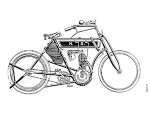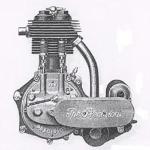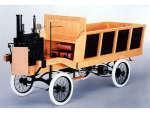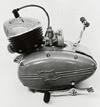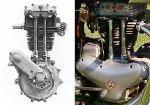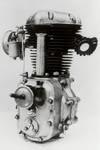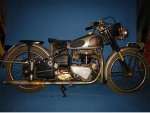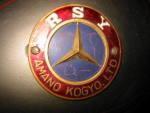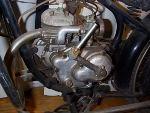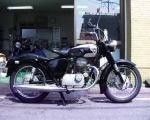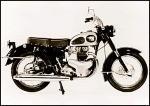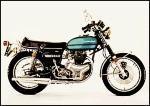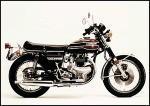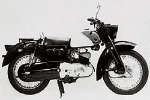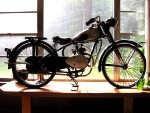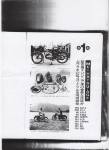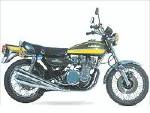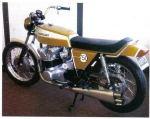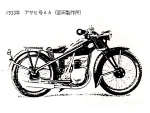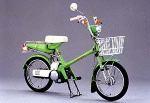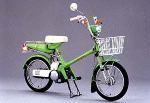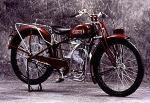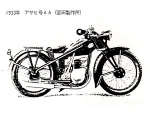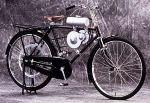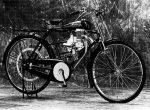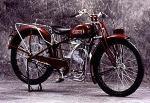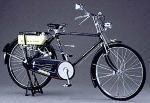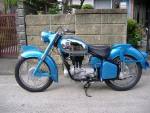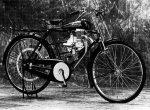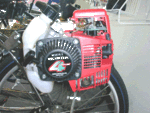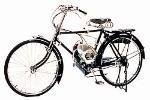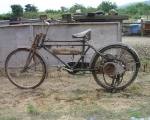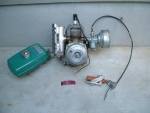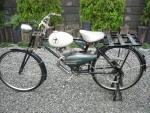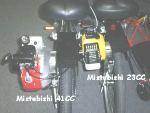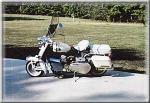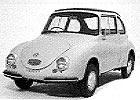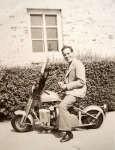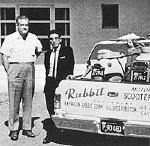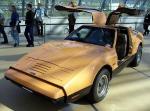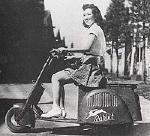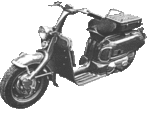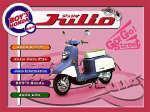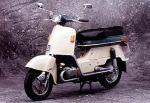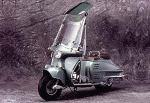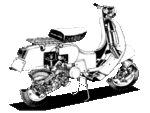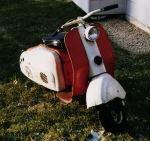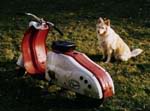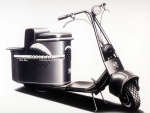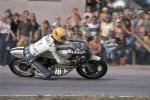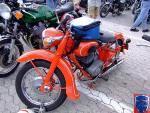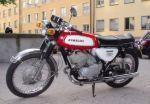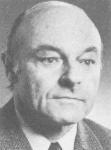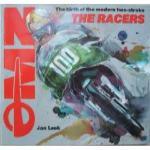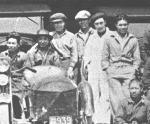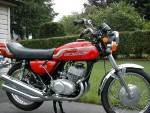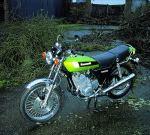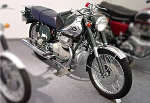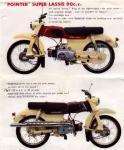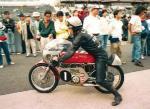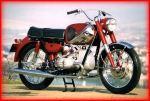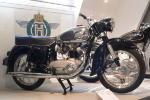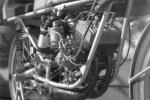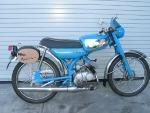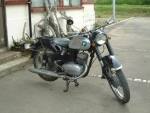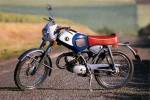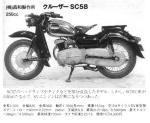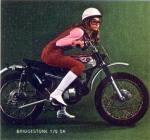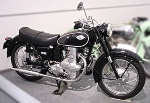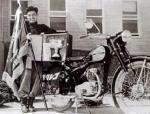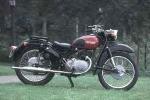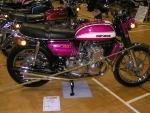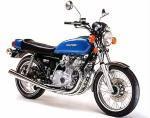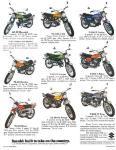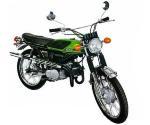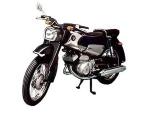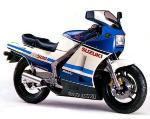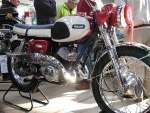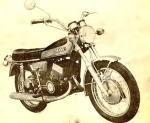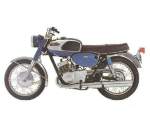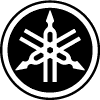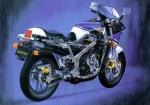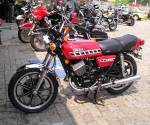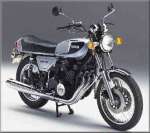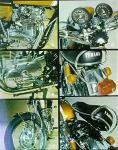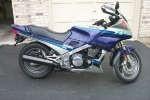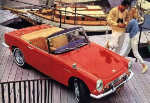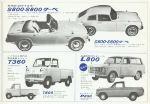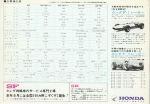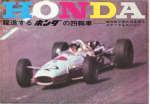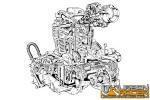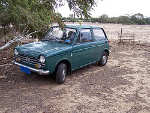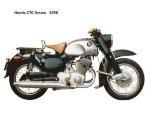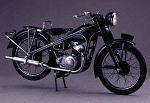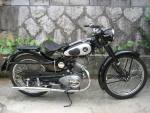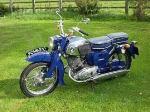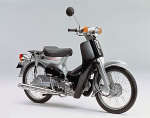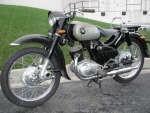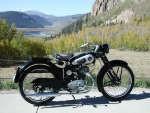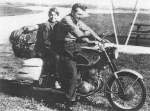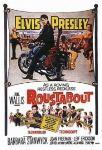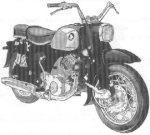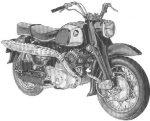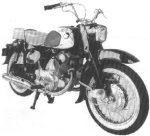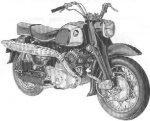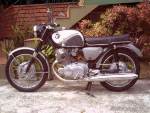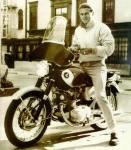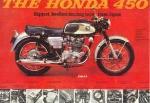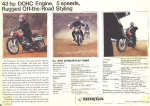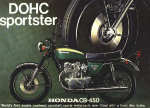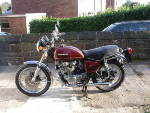THE TWO STROKE MOTORCYCLES.
At this stage, we can start to examine, how the two-stroke technologies were developed in Japan. After the WW2 the prewar model, two stroke motorbike RT-125 developed under the trademark IFA (Industrieverwaltung Fahrzeugbau) in Eastern Germany and the West German copy part DKW became patent free. This was a part of the war reparations.
England copied it and developed the BSA Bantam, HD copied it and developed the Hummer, Sovjet Union copied it and started to make the M1 Mockba (Moskva),and Voskhod and in Poland they made the Polish WSK. Yamaha copied it and made their first motorbike Ya-1 which was an exact copy of the RT-125, originally developed by East German Company IFA but drawings left to DKW in West Germany.
.
ABOVE THE YAMAHA YA-1, BELOW THE DKW RT-125
Yamahas next model was a copy of DKW’s RT-175 and the next model YD1 was a copy of ADLER 250, which was a very advanced model. I am not sure if DKW had any influence on Adler but anyhow Yamaha copied the Adler 250 to make their YD-1. Yamaha had and have some strange underground relation to DKW and today with Auto Union and Audi as they are called today. For example Yamaha and Audi are still the only manufacturers of the Yamaha patented 5 valve technology. Toyota has to manufacture their 5 valve engines at Yamaha under Yamahas patent. Maybe it is payback time for Yamaha to Audi….
Okay here you can see the Adler original and the Yamaha copy
ADLER RS250
ADLER RS250
YAMAHAYD-1
YAMAHA YD1
From this Yamaha developed the very successful YDS 250 line. I bought a new one in 1967, the first one with electrical start. Probably I was lazy already then.
Yamaha was a fast learner and, within a few years, its twin had cast off all traces of its Adler origins and had given rise to a new model dynasty. They used the GK design company, nowadays one of Japan's leading design consultancies. GK was founded in 1953 by four ex-students of Iwataro Koike at the Tokyo National University of Fine Arts and Music—the company's initials deriving from ‘Gruppe Koike’ They are a very successful and one other design for which they are the Kikkoman bottle which have stayed unchanged for soon 50 years. They are still today responsible for the “look” of Yamaha’s models.
Then came the first dedicated sports models, the YDS1 and the YDS2 (the first model exported to Europe). Yamaha competed in its first French GP at Clermont-Ferrand in 1961 and returned in 1965 with a succession of famous riders like Don Vesco, Phil Read, Jim Redman, Bill Ivy, Jarno Saarinen, and Giacomo Agostini.
In 1957 Adler together with Triumph TWN, the German Triumph branch was sold to Grundig the largest radio/TV manufacturer in German by then they modified the factories to manufacture type writers on the brand name of Triumph-Adler and I must confess that my old mother have one….Later the company was sold to the Italian Olivetti but motorcycle manufacturing was never continued, it was a pity….
Suzuki also copied the DKW/IFA and ADLER for their twins, but their break trough came a few years later in 1961, when they bought Ernst Degner, an East German GP rider for former IFA now MZ, and smuggled him out from the Swedish GP 1961 in south Sweden town of Kristianstad, together with bikes and all drawings for the MZ bikes. Degner could have won the race, which he was leading, and thus securing the world championships, but he got an engine “failure” early in the race and had to quit the race and left the circuit in advance, not heading to the ferry to DDR but to Denmark and West Germany and from there to Japan. The escape was quite adventurous and made, beside his old home country DDR, also his former “backer” the genius behind MZ and the two stroke technology Walter Kaaden very upset. Same was his team mate Alan Shephard who said "Degner was very much in love with himself and did not hesitate to hurt other people. I feel what he did was very, very cruel."
Anyhow Walter Kaaden’s history was also quite fascinating. He was during the WW2 an associate to Mr Werner von Braun who was the mastermind behind the Germans Nazi V-Series rockets that hit England. Mr Braun was getting a proposal, either jail or join the US space program . He joined and was later the mastermind behind the US moon travels.
Probably Mr Kaaden, who was one of the mastermind behind the first Nazi’s cruising missiles decided to stay in East Germany, being a devoted Communist and having a deep love for the Fatherland. Kaaden actually worked later as a carpenter in what became East Germany. His love of motorcycles drew him to racing and through a complicated process, he became the head of DKW's race team, and later, MZ.
Mr Kaaden was the mastermind behind modern two stroke technology. He developed the importance of the design of exhaust systems in two strokes design, maintaining a contra pressure from the exhaust and turned that knowledge into mathematical functions. Walter Kaaden influenced road racing for decades, first through MZ and later with the stolen secrets at Suzuki and Yamaha.
His 1961 125cc race engine design was the first engine to achieve an output of 200BHP/litre. His revolutionary two stroke system was copied widely in the sixties by Japanese manufacturers.Yamaha and Suzuki two-stroke engines became competitive in motor sport only after they gained possession of MZ design secrets. MZs were ridden to 13 GP victories and a further 105 podium places between 1955 and 1976, the last one being a third place by Finn Tapio Virtanen at the Swedish GP in Anderstorp with me being in the paddock.
TAPIO VIRTANEN ON A 250 MZ AT FINNISH GRAND PRIX SAME YEAR MZ GOT THEIR LAST PODIUM
Mr Kaaden probably never understood how much he had influenced the Motorcycle Industry. My old Swedish friend Janne Leek (haven’t seen him for 40 years) was able to interview him before just before he died and did a book about the MZ racing story.
MZ RACING HISTORY
Everything that Yamaha and Suzuki achieved with two strokes machines on the racing circuits and on the public sales should partly be devoted to Mr Kaaden, DKW IFA and ADLER, their secrets were stolen….
Suzuki won the 50 cc world championship already the next year after Mr Degner left German. The design was 100% MZ.
Degner actually repatriated himself back into East Germany after retiring from racing (there's a corner at Suzuka named after him). He killed himself, allegedly by slitting his own throat, in Berlin in the 1990s. According to some other sources he took an overdose of the pain medicines he was taking to ease the pain he had after a crash at the Suzuka circuit.
It's been a matter of speculation for years that his death wasn't suicide at all.
ERNST DEGNER SERVICING HIS BIKE
WALTER KAADEN
KAWASAKI TWO STROKES.
Kawasaki’s four stroke background has we already dealt with maybe I should have talked more about the GPZ900R, a picture maybe wasn’t enough, because that model is the mother of all new Kawasaki’s.
Anyhow I will here only shortly go through the most important Kawasaki two-stroke models. Kawasaki was not very active in the two stroke field before the failure of Bridgestone motorcycles. After that some of the engineers from Bridgestone and former Tohatsu joined Kawasaki and brought with them the state of the art two stroke technology. Then already in 1967 they presented a 250cc and a 350cc copy of the BRIDGESTONE GTO, The cylinders though were iron sleeved not Nicasil powdered aluminum. The 250 A1Samurai developed 31 hp at 8000 rpm, the A7 350 Avenger developed 42 hp at the same rpm. The stroke was the same in both machines so the extra capacity was got by a bigger bore. The gear box was 5 speed. The frame and chassis inclusive brakes were the same on both bikes.
Then in 1969 Kawasaki presented their first triple. The HR1 500cc, It was followed by the 250 S1 and 350 S2 in 1971 and in 1972 came the 750cc Mach UV nicknamed “Widow maker” The triples were manufactured up to 1980 except the Mach IV which ended, maybe because of all accidents already, in 1975. The 250 S2 and the 350 S3 were not more powerful than their 2-cylinders competetitors but the Mach IV and the HR1 had both a very dangerous hp/kg ratio which made spectacular wheelies and many accident, The handling of both bikes was very, very poor also. The HR1 had 60 hp at 7.500 rpm and it weighted 174 kg. Compare that to a Triumph TT100SS with 30 hp and 230 kg….The Mach IV had 74 hp at 6.800 rpm and the weight was 205 kg. They were made for wheelies!!!!! Some pictures:
KAWASAKI 250 cc AI SAMURAI.
KAWASAKI350 A7 AVENGER 1967
KAWASAKI HR1 500 cc
KAWASAKI 250cc A1 TRIPLE
KAWASAKI 350 cc A2 TRIPPLE
KAWASAKI MACH IV, “THE WIDOW MAKER”
MARUSHO.
Marusho was one who copied quite visible. It was started in 1948 as Marusho Shokai Ltd. Their motorcycles were often sold also on the Lilac brand.
The man behind the company was Masashi Itoh and he is told to have been attending a management course together with Soichiro Honda or/and worked at Soichiro Hondas garage 1940-1935 but all this is unconfirmed. Anyhow this enclosed picture shows the two in front of Soichiro Hondas ART garage about 1931-1932.
ITOH AND HONDA, ITOH SITTING IN THE SIDECAR HONDA STANDING WITH HIS HANDS IN THE POCKETS.
The first Marusho was a model called ML and sometimes referred to as the LA, was ready in 1950 or 1948). Mass production of this ML series 150cc single, copied from a a pre-war Zundapp, began in 1951 in Hammamtsu. The bike had shaft drive which became the trademark of Marusho,. In 1951 the name of the company was changed to the Marusho Motorcycle Industrial Co., Ltd.
From 1951 1961, Marusho made 31 different models of motorcycles under the name Lilac, all but 2 of which were shaft-driven.
Here is some samples and enjoy the pictures.
.
MARUSHIN”S FIRST MODELS ML, LB, LC ml had a side valve engine of 242 cc and the newer model had the same engine but OHV.
THIS IS THE ZUNDAPP MODELL THEY GOT INSPIRATION FROM
Marusho’s next model range was the VICTORIA BURGMEISTER inspired V-twin range:
MARUSHO/LILAC 250 1959 and 1960
They started export 1963 or early 1964. In U.S the first model was called Imperial but the war memories forced them to change the name to ST.
About 600 of these 500cc opposed twins were produced for the 1965 model year, primarily for the U.S. market. 150 of these are still registered in US.Black and Silver were the basic color, with a few painted the optional candy apple red. The cylinders were silver, the carburetors 22mm, the tool box on the right side cast aluminum.. The V-twins Marushos you could switch the gear from 4th to 1 gear only having a warning lamp when it was safe to up-gear. The 500 model had the feature disabled but the warning light was left.
Incidentally, the '9' and the '2' in the serial prefixes yield 'R92'. The few of this model that were badged as Lilacs for the non-U.S. market, were known as model R92. There are 150 STs in the Register, and the register excludes known examples where the serial numbers are not known. It is reasonable to conjecture that half of all Marushos are still retained by enthusiasts.
The last bike Lilac built was the Electra. Despite flagging sales of the Magnum, numerous changes were made including the electric starter (reportedly from an Italian car), a cartridge oil filter system, 2 (count 'em) big alloy side covers (one for the tools and one for symmetry), thick cylinders and a chromed grab bar at the rear of the seat. Ads mentioned an upcoming bored-out 600cc version and even a planned 750cc. The electric start concept was about as effective as BMW's first try, that is, the tiny battery was only good for a few seconds, but there was a usable kick-starter tucked in very tight against the left-hand side cover. It condemned the decal on the cover to being destroyed right away, and the fact that there was no choke or even a tickler on this model meant that starting could be a chore.
THE BABY LILAC 1959
LILAC 350 BMW COPY
LILAC BMW R27 COPY
VICTORIA BURGMEISTER FROM WHICH LILAC V-TWINS WERE COPIED
THE LAST MARUSHO/LILAC THE MAGNUMELECTRA.
SHIN MEIWA/KAWANISHI.
Kawanishi was an aircraft company most famous for its flying boat planes especially the H8K EMILY which was by far the best flying boat until a long time after WW2. They also made the Shidden Fighter which outperformed the B29’s by far. Actually Kawanishi (now renamed SHIN MEIWA Corporation) started to build updated versions of the flying boats again for the Japanese Navy again in the 1950’s and they were still doing it still in 1980’s. These planes were not threatened in the same way as Fighters planes since these were for self defense.
The Kawanishi aircraft company also faced the same problems like Mitsubishi and Nakajima, what to do? Anyhow they chose a little different approach. Instead of starting making scooters they started to make engines for the quickly growing motorized bicycle industry. The engine was 64cc engine and they sold it to other manufacturers of motorized bicycles when they started to run out of WW2 surplus engines. When in 1948 Kawanishi was reorganized as Shin Meiwa they started to be serious about motorcycles. They put their 64cc in their own bicycle not horizontally but vertically and in 1949 they introduced a 142cc side valve four stroke with 2,5 hp at 2750 rpm. The rpm limit was chosen according to aircraft standards, over that 2750 rpm propellers start to detoriate so they thought that there is some magic in that….
Soon after they introduced a new Meiwa with a 250cc OHV placed in a Sports bike called the Pointer. These bikes were very popular and sold well.
The next model was called ACE 250 and it had a square 69mmx68mm engine and the engine is regarded as maybe the best early post war design in Japan. The engine had double exhaust ports, compression rate was 6,5-1 and the pushrod engine developed 12 hp at 5.500 rpm. It had a 3-speed gearbox, a dry multi plate clutch, crankcase of aluminum, battery and coil ignition and it could do100 km/h, a huge speed at that time.
Even if the reliability was better it was still not so good, the crank gave up after 15.000 km and your journeys were uphold all the time by minor repair work….
Shin Meiwa stopped motorcycle production in 1959. It is unclear for me if this Shin Meiwa has anything to do with today’s Shin Meiwa making filters for motorcycles.
The only picture I found were these.
.
POINTER
POINTER 90 CC
TOHATSU.
Tohatsu Corporation of Tokyo, (Tokyo Hatsudoki) Japan, was founded in 1922. Today it manufactures outboard motors, pleasure boats, portable fire pumps, small fire trucks, pumps for construction and drainage, refrigeration units for transportation.
The company was originally named Takata Motor Research Institute, and manufactured railcars. Research and development of high-speed, portable engine generators and radio-controlled generators began soon after and were brought to production in 1930. During the war the production was turned into satisfying the Imperial army. In 1950, production and sales of motorcycles began. 1955 brought aggressive growth to Tohatsu. Capital increased to 300 million yen, new machinery was bought and production on a new line of engines started. Sales offices were established in Fukuoka, Nagoya, Tokyo, Sendai and Sapporo. Dealers were set up throughout Japan.
Tohatsu quickly changed from only being an engine supplier for the bicycle industry into becoming a manufacturer of sporty small bikes. In 1962 they introduced the Tohatsu Runpet Sport CA-2. This bike raced both in road racing as well as motocross. It had a 49cc 2-stroke rotary disc valve engine supplying 6hp at 9.200 rpm, a really amazing performance for such a small bike.
Tohatsu also manufactured the first Japanese Production Racer the Runpet Racer CR. It was highly successful in Japanese races and it also reached the European continent. The engine was slightly tuned version of the CA model delivering 6,8 hp at 10.500 Rpm and had a top speed over 100 km/h through a 4 speed gear box.
In the early 1960’s Tohatsu was a cutting edge two stroke manufacturer and made the world's only production 50cc twin-cylinder road race machines as well as a disc-valved, twin-cylinder 125cc racer
According to some sources they had a 20% market share in the late 1950’s. Tohatsu held 3% of the Japanese domestic motorcycle market in 1961.
Unfortunally Tohatsu stopped the motorcycle manufacturing in the middle of the 1960’s. According to some sources it was overtaken by Bridgestone, others say that most of the engineers joined Bridgestone.
TOHATSU TWO STROKE TWIN ON THE RACE TRACK
TOHATSU TWO STROKE 125 1956.
TOHATSU TWIN 125 RACING
TOHATSU RUNPET SPORT AND RACER
HODAKA AND YAMAGUCHI.
The history of Yamaguchi and Hodaka are linked closely together. Hodaka is worth a long thread itself but I will only briefly tell the story.
Pabatco headquarters were in a small rural town called Athena (population: 1000). The company was established in 1961 as a division of Farm Chemicals of Oregon, which distributed fertilizer throughout the Pacific Northwest. To increase their business, the company management planned to trade locally grown products on a barter deal with other countries. The Japanese needed American wheat and other crops, and through barter trade the currency regulations could be side stepped.
This is how Pabatco met Yamaguchi, a motorcycle factory in Japan and motorcycles became quickly Pabatco’s most significant business. By 1963, Pabatco had imported 5000 machines and distributed them through its 480 dealers. But in April of 1963, Yamaguchi suddenly went bankrupt, leaving Pabatco and well-established dealer network with nothing to sell.
Now the American Hodaka story begins. Yamaguchi's bankruptcy, left Pabatco with an idle network and at the same time it threatened to force the engine supplier of Yamaguchi, the Hodaka Industrial Company of Nagoya into bankruptcy. Swift, creative thinking from the FERTILIZER COMPANY Pabatco brought them to the only acceptable conclusion: "Let's build our own bike!"
After all, these enthusiasts knew what American buyers wanted, the Hodaka engineers knew how to build engines and transmissions, and with the help of some new employees from the off road motorcycle society. they put together their own motorbike. Pabatco offered to design and market the bike if Hodaka - whose name in Japanese means "to grow higher" - would adapt its factory to manufacture and assemble the entire machine. Seeing as how it didn't have a lot of options, with 300 engines still sitting on its factory floor, Hodaka agreed.
And the HODAKA boom was born. Hodaka sold tens of Thousands bikes on the US market creating the “off road boom” without need to be a racer…
About Yamagushi is not so much written, except of its connection with HODAKA.
YAMAGUCHI
Below is a Maserati copied sports bike called Autopet Sports SBP. It had a 50cc 4-speed Hodaka engine with 4,8 hp at 8.200rpm. Max speed 80 km/h.
YAMAGUCHI 50cc AUTOPET SPORTS SBP
The rest of the HODAKA story I save to another time. Let us just sum up that already in 1966 Pabatco was sold to SHELL who actually kept on distributing motorcycles between 50-250 cc up to 1977 when the HODAKA factory in Japan went out of business. Shell even tried to buy the factory but the seller refused and closed the doors instead. Below something for your eyes.
HODAKA 100CC
MONARCH.
It is difficult to find information about the Monarch brand, despite that it has been allowed into the Honda Museum from where the picture below is picked.
Anyhow this 246cc OHV engine has copied the English brand VELOCETTE when constructing this bike. It has 14hp at 5000 rpm and could make 120 km/h. It was successful in the Asama Highland race in 1955 with it’s racing version, The bike below is the civilian version of the racing bike and a 1956 model. It is unclear what other models they made have make und I don’t know when they started motorcycling manufacturing and what happened to the company. It stopped motorcycle manufacturing in 1962 and the last year it manufactured one cylinder Norton copies 346-496 cc.
MONARCH 250 OHV A VELOCETTE COPY
HOSK.
Hosk is a very interesting manufacturer, only producing bikes between 1953-1957. The made both two-strokes and four strokes from 195-500 cc. But why it is an interesting company is because it is the origin of Yamahas very successful XS 650 twin.
In 1956/1957 they copied a very modern designed German Horex 500 SOHC bike and made a bike that was actually faster than the original but very expensive and unreliable. Hosk run into financial problems and was overtaken by SHOWA improved the 500 HOSK and sold it for some years. They also developed prototype of a 650 twin made by the same engineers that copied and developed the HOREX. It seems that most of engineers from HOSK were employed by SHOWA. In the early 1960’s Showa’s motorcycle business was sold to Yamaha and again the old “HOREX” engineers where employed by Yamaha , At Yamaha the same engineers continued their work and in 1968 Yamaha were ready to present the best 650 parallel Twin ever made the XS650. That bike was to be sold almost unchanged for almost twenty years. It was also from HOSK’s engineers that YAMAHA got their 4-stroke know how which thy needed when the two-strokes came to their end, because of emission regulations.
THE HERITAGE OF YAMAHA XS650 HOREX 500 SOHC
THE HOSK VERSIONPROBABLY HOSK HAD MOVED THE CAMSHAFT CHAIN TO THE SIDE ON THIS MODEL
SHOWA MOTORCYCLES
SHOWA was another very innovative company making motorcycles between 1948-1960. Being a newcomer on the market it invested from the start in very high quality manufacturing equipment. Showa, in particular, was one of the first Japanese companies to import automated factory equipment to turn out machines.
Showa was also one of the most innovative of the Japanese manufacturers.
Anyhow their first product was probably a simple auxiliary engine for bicycles.
SHOWA developed then the first chain driven OHC (overhead camshaft) motorcycle seen in Japan the SH model. It had a 150cc engine delivering 5 hp at 4,800 rpm and had a top speed of 80 km/h through a 2-speed gearbox. The next model had already 6,2 hp and a 3 speed gearbox and it won the NAGOUA TT in 1953 defeating HONDA’S factory team on Honda Dream E’s. The story says that it was at this stage Soichiro Honda started to think about OHC engines.
Despite success on the race track, Showa found out that the OHC engine was a nightmare for its dealers to service. The cam chain snapped routinely, and oil leaked from all surfaces no matter what gasket they developed.
This forced SHOWA into a short and unsuccessful excursion into side valves before they turned their interest into two-strokers and copying DKW/IFA.
In 1956 the company introduced the Light Cruiser, a 125cc single two stroke with reed valves, the first time reed valves were used on a Japanese two stroke.
With the same displacement and bore and stroke as the Yamaha, the Showa reed design gave the Light Cruiser one more pony than the YA-1.
The same year Showa also marketed the first Japanese two stroke twin, a 350 with beryllium copper reed valves. Bore and stroke was 62 by 58mm. The compression ratio was 6 to 1, and the output was a fantastic 22hp at 5,500 rpm.
I have not been able to find out whether the SHOWA motorcycles have anything to do with the famous suspension company SHOWA CORPORATION of today.
SHOWA 250
SHOWA 250
SHOWA 250
BRIDGESTONE MOTORCYCLES
Mr Shojiro Ishibashi (translated in English “Stone Bridge”) started in the1920’s to make rubber soled shoes.
In 1925 he began mass production. After the WW2 he increased the range of rubber products, started manufacturing bicycles and when there was demand for simple bicycle engines he outsourced the manufacturing of simple engines to be sold as Bridgestone and often together with Bridgestone bicycles.
Bridgestone also had at this time a quite big car industry producing 5000 vehicles a month on the brand of PRINCE.
When the cyclomotor boom was over they started to manufacture small motorcycles The first recognizable motorcycle was produced in 1958. This was the BS "Champion" range, a contemporary pressed-steel frame motorcycle with a 50cc fan-cooled two-stroke engine and three-speed gearbox. The 1962 version of this machine (the Champion-III) was later sold in the U.S. as the Bridgestone "Super 7", along with a step-through framed version known as the "BS-50 Homer".
By 1964 things had changed with Bridgestone producing a range of high quality lightweight motorcycles. With the closure of the Tohatsu and Lilac factories, Bridgestone found themselves in the position of being able to employ clever, experienced designers who would set the benchmark for innovation.
The Tohatsu engineers in particular had a major influence on the development of Bridgestone motorcycles. Although now almost an unknown name, Tohatsu held 3% of the Japanese domestic motorcycle market in 1961. Tohatsu was a most innovative manufacturer and made the world's only production 50cc twin-cylinder road race machines as well as a, disc-valved, twin-cylinder 125cc racer. When the factory folded in February 1964 it was on the point of launching a full blown Grand Prix effort headed by Englishman Dave Simmonds - who later went on to win Kawasaki's first ever World Championship in 1969.
Tohatsu's disappearance was a bingo for Bridgestone. They got hold of the most high skilled two stroke know how in Japan and they already had the IFA/DKW and ARDELL designs.
BRIDGESTONE quickly introduced a quite impressive range of model, everything with engines, 350cc, 200cc, 175cc, 100cc, 60cc, 50cc,
BRIDGESTONE was by far the best developed bike at this time with a quality far beyond its competitors. Bridgestone sold bikes with expensive technical solutions not seen before. The best way to express how good the Bridgestone was is to let a Bridgestone brochure talk:
1. Bridgestone designed and built the first dual-rotary valve, dual carburetor engine ever used in a production motorcycle -- the 175+ Dual Twin. Cycle World acclaimed it "a design breakthrough in production motorcycles that all others will be obliged to follow."
2. Instead of conventional 2-cycle fuel induction, Bridgestone engines have rotary disc valves. That's one of the main reasons for the incredible acceleration of Bridgestone cycles. Most experts agree that the rotary valve brought the 2-cycle engines to the peak of its efficiency and performance potential.
3. Bridgestone introduced motorcycle engines with aluminum alloy cylinders and hard-chromed bores, a Bridgestone exclusive. To you, this difference means better performance, substantially reduced maintenance for as long as you own your Bridgestone . And, Bridgestone engines are "clean"... everything is enclosed, including the carburetor.
4. Bridgestone designed and built the first selective four-speed / five-speed motorcycle transmission for economical overdrive cruising at highway speeds. This transmission is standard equipment on every Bridgestone 175+cc Dual Twin and Hurricane Scrambler.
5. Most competitive models place neutral half way between 1st and 2nd gears. You have to have a toe as sensitive as a surgeon's hand to find it. The Bridgestone full rotary shift gives it a spot right after 4th gear. When you come to a stop, jus t tap the shift pedal. You're in neutral without shifting back through all the gears and then trying to find that elusive neutral. On 5-speed models, neutral is placed in front of first gear so you always find it with ease.
6. There are quick-change rear sprockets on Bridgestone's two off-the-road motorcycles -- the 90+ Trail and the 90+ Mountain. This permits you to change them from 60-mph street machines to mountain-climbing trail cycles in minutes. Only Bridgestone has the quick-change rear-sprocket.
7. Competitive models use the transmission gears and the engaged clutch as part of the kick starting system. Since the clutch must be engaged to turn the engine over, the machine must be in neutral to be started. If stalled in traffic, neutral can be hard to find. (Can you hear the horns blowing?) Because Bridgestone cycles have an independent set of starter gears, the cycle can be started in any gear. Just squeeze the clutch and kick. You have to have been stalled in traffic just once to appreciate this feature.
8. Every Bridgestone is equipped with special tires to match its performance (at no extra cost to you). We can afford to do this because Bridgestone also is Japan's largest tire manufacturer.
9. Bridgestones have special shock absorbers. As the wheels move up and down over a bump, the shock is absorbed first by a coil spring, then by an oil cushion, and finally by compressed air, which gives a smoother ride, without damping out the "feel" of the road.
10. Bridgestone Oil injection not only eliminates the need to pre-mix an oil-gas fuel mixture but it automatically adjusts the amount of oil mixed with the gas so that it is exactly right under any operating conditions. Bridgestone Oil injection offers FULL TIME lubrication since the oil pump is driven by a gear located on the end of the crankshaft. This means that any time the engine is running it is receiving an adequate supply of 2-cycle oil. (Some competitive models drive the oil pump off t he clutch shaft. This means no oil is pumped when the clutch is disengaged.)
11. The brakes on every Bridgestone are bigger than they need to be. We even waterproof them to assure you safe, sure stops in any weather.
12. Every cycle goes through a 27-point check on a dynamometer before it leaves the factory. In addition, a completed cycle is periodically picked at random from production, ridden under the toughest conditions, and then torn down completely. Each part is inspected and measured for wear.
So why did such a fantastic brand disappear? According to one rumor the BIG FOUR (Honda, Yamaha, Suzuki and Kawasaki) invited Bridgestone to a meeting at a hotel in Tokyo to tell Bridgestone what happens if Bridgestone not quit motorcycle manufacturing. They all turn to other tire manufacturers. According to the rumor their threat was accompanied by some Yakuza men at the meeting. (Yakuza is a Japanese gangster and very feared)
Probably the truth is much simpler. Bridgestone was a huge tire company and they needed more production sites, Also the Bridgestone despite being damned good were expensive to manufacture and thus expensive in the show room.. Another point was that Bridgestone didn’t have a very strong distribution. They sold the bikes in US through Rockford Motors, Inc. of Rockford, Illinois. A decent dealer network was never effectively established in the US. The bikes, being a notch above the competition in finish, technology and performance, also cost more on the showroom floor and this probably hurt sales. For ex, the GTO 350 cost as much as a Triumph Bonneville but was on the other hand faster and much more reliable. Also they read the handwriting on the wall concerning the future of two-stroke road bikes and didn't want to invest in a whole new line of four-stroke machines for a business that was already lagging.Anyhow Bridgestone quit the motorcycle business and sold all the tooling to BS Tailung in Taiwan who continued to make mostly 50-100 cc bikes, most of the to Rockford Motors who sold them as CHIBI, TORA and TAKA up until 1975.
BRIDGESTONE PICTURES
THE FLAGSHIP THE GTR 350 BRIDGESTONE
SOME BRIDGESTONE SCRAMBLING
RACE READY BRIDGESTONE
BRIDGESTONE 100 WITH AUTOLUBE!!!!
BRIDGESTONE 90 cc LINE UP
THE LAST BRIDGESTONES MADE IN TAIWAN
THE REST OF THE SUZUKI STORY
The Suzuki Motor Company was founded by Michio Suzuki, a son to a Japanese cotton farmer. He was born in, where else than, Hamamatsu, a small town 200 km from Tokyo, in 1887. As Michio grew up he became a carpenter and an enterprising young man. In 1909, at the age of 22, he constructed a pedal-driven wooden loom, and started to sell his product. Suzuki Loom Works was founded. The business went well, the order stock was growing and Michio Suzuki further developed his machine for the silk industry. New, much more sophisticated machineries were developed and the business was blooming.
Eleven years later, in 1920, Michio Suzuki decided to introduce his business to the stock exchange. The days of a small family business were long gone; Michio Suzuki needed the capital to be able to expand the business to meet the demands of the growing market. The founding of Suzuki Loom Manufacturing Company (Suzuki Jidosha Kogyo) in March of 1920 is regarded as the start of the Suzuki Motor Company as we know it today. The company celebrated its 80-year anniversary in 2000.
Suzuki Loom Manufacturing Company got the capital needed for the investments and the company was now growing fast. Already in 1922 the Suzuki Jidosha Kogyo was one of the largest loom manufacturers in Japan.
By that time, Japan was not the large industrial power that it is known today. The most important export items were fabrics and cloths. In 1926 the new-established Suzuki Loom Manufacturing Company started to export looms to the Southeast Asia and India. But the market was soon to be sated, the high-quality looms from Suzuki lasted practically forever and the demand for new looms was getting gradually smaller. Suzuki started to consider manufacturing other things on the side of the weaving machines.
Suzuki Loom Manufacturing Company is an impressive company but there’s little demand for its products. Suzuki considered going into the automotive business. 20,000 vehicles were imported to Japan annually, still not satisfying the growing demand for cheap commuting vehicles. Michio Suzuki noticed the market gap and made his first move.
In 1938 Suzuki made its first prototype of a car, based on the Austin Seven. The Suzuki research team had bought an Austin from England, dismantled and studied it and a few months later was able to make a replica of the British 737cc car. Japan possessed little technical knowledge of how to produce good cars or motorcycles and imitating the car manufacturers in Europe seemed to be the way to get started.
But the timing was lousy. Japan was already preparing for the war. The project was abandoned and the Suzuki’s version of the Austin Seven was never mass produced. That wouldn't have been that original idea anyhow, Nissan's first automobile was based on Austin Seven.
After the war followed a period of rebuilding and economic instability. The manufacturing of weaving looms was renewed but a wave of strikes at the forties and in the beginning of the fifties and the post-war chaotic financial structure nearly destroyed the Suzuki Loom manufacturing Company.
According to a story it was Michio Suzuki’s son, Shunzo, who came with the idea of motorizing his bicycle a fall day when riding home from a fishing trip. Without any specific goal, only for his own pleasure, Shunzo went to his drawing board at home and started to design his own cyclomotor. Nevertheless the story is true or not, manufacturing cyclomotors saved the company from the edge of a crash.
In November 1951 the engineers of the Suzuki Loom Manufacturing Company started to design an engine that could be attached to a bicycle. The idea was not unique, there were actually over 100 other Japanese companies that had came up with the same idea. Soichiro Honda started his Honda Technical Research Institute in 1946 with renovating used small engines used by the Japanese army during the war and mounted them onto bicycles. A year later Honda started to make their own engines. By the time Suzuki put his first cyclemotor into production Honda (now renamed to Honda Motor Company) owned 70% of the commuting market.
The name of the company was changed to Suzuki Motor Company in June 1954 and the former weaving machine builders began building motorcycles.
The first models, presented in 1952 were pure motorized bicycles. The first model was power free, a 36cc two-stroker, quickly followed by the 60 cc Diamond Free. The success on the racing trails of mount Fuji gave the Diamond Free great publicity and Suzuki Loom Manufacturing Company piles of orders of the Diamond Free. Up to 6,000 units a month were made of the successful cyclomotor. The Diamond Free was such a great success for the loom manufacturer that the company decided to concentrate on designing and building high quality motorcycles. Because of the huge success Suzuki decided to concentrate on motorcycles and changed the name from Suzuki Jidosha Kogyo (SJK) to SUZUKI MOTOR COMPANY in 1954. Despite of this they still didn’t sell their bikes as Suzuki, On the engine you could see SJK and the different product lines had different names.
When the cyclomotor boom was over Suzuki went into producing bigger motorcycles, The first motorcycle model was probably MINI FREE but it is still very much of a bicycle.
MINI FREE 1954
This was again quickly followed by PORTER FREE in 1956.
PORTER FREE 1956
The already in 1954 Suzuki had introduced the COLLEDA bikes the first model called CO, a 90cc four stroke. This bike won the FUJI race in its class, and this strengthen the sale. Remember that 90 cc four stroke still didn’t require a driving license to ride.
SUZUKI COLLEDA 90 CC FUJI WINNER
CIVIL VERSION OF COLLEDA ST6A IN 1959
In 1955 Suzuki was the 8th biggest manufacturer among 200!!! In 1956 it was up to 5th. It wasn’t until 1958 that Suzuki started to use SUZUKI as its brand name and the characteristic
Suzuki as well as Honda had the same idea that by generating high incomes from making simple bikes in huge amounts the income stream should be used to develop cutting edge products for further grow.
The Colleda 250 TT would be a very nice example of the later. In 1956 it had 16hp against Honda’s ME 14 hp and Yamaha YD-1 14,5 hp. Tight competition.
SUZUKI COLLEDA TWIN TT 1956
Suzuki developed still in 1959 a two cylinder 125 cc with electric start, the first electric start on a Japanese bike. They named it Colleda Seltwin and the two stroke 123 cc engine developed 10 hp at 8000rpm. Maximum speed was 110 km.
SUZUKI COLLEDA SELTWIN 125 cc TWIN AND ELECTRIC START.
Then in 1963 Suzuki became Suzuki and in the 1964 product line all bikes were called SUZUKI. The bikes were still the refreshed Colledas but now carried the SUZUZKI logo. The 250 twin was called T-10 and next year it cganged totally when Suzuki presented the T-20 a revolutionary bike. Imagine in 1965 a 6-speed gearbox, oil-injection no need to mix oil and gasoline anymore, 29 hp at 7,500 rpm, power figures same as a 500 TT100 Triumph at that time. The weight was only 135 kg a, the brakes were big, handling good and the styling and finish was superb. The bike was sold for many years and was called T20 in Europe and X6 or HUSTLER in US.
SUZUKI T-20/X6/HUSTLER
Suzuki also introduced a Scrambler version in 1967
SUZUKI 250 SCRAMBLER.
Then in 1968 SUZUKI introduced the T500 also called COBRA and TITAN. The bike’s weight was 187 kg and the 500 cc engine delivered a huge 46 hp at 7000 rpm. The bike had a 5-speed gear box probably SUZUKI thought that it doesn’t need a sixth gear.
SUZUKI T 500/COBRA/TITAN
Then in 1969 SUZUKI presented a beautiful 125cc twin. It had15 hp at 8.500 rpm, 5 speed gearbox, it’s weight was 96 kg and it had upswept pipes. A real beauty.
SUZUKI TS125II STINGER.
When the century changed Suzuki tried to conquer the world with pure two-stroke, air cold bikes while it’s main competitors already had turned into 4-stroke technology. In US they had this product line:
THE AMERICAN 1970 LINEUP.
But then things start to happen, but not in the way you would imagine. Suzuki continued to trust 2-troke technology. In 1971 they presented the mighty GT-750. It was provided with a rubber mounted 3-cylinder in line water cooled 2-stroke engine providing 67 hp at 6500 rpm. The dry weight was 214 kg. The bike became quickly nicknamed the “WATER BUFFALO”. It was produced up to 1977 with minor changes, the biggest being changing the front drum brake to double discs in 1973.
SUZUKI GT 750 THE WATER BUFFALO.
In 1972 SUZUKI presented the new GT550 and the smaller GT380. Both had cooling provided by a “RAM AIR SYSTEM” which was aluminum scoop who collected the cooling air more efficiently. Both bikes were 2-stroke twins, the 550 provided 50 hp at 6500 rpm, the 380 38 at 7500 rpm. The first year the GT380 still had front drum brake.
SUZUKI GT380
SUZUKI GT550
Then in 1975 Suzuki made it’s last effort to avoid 4-stroke technology. They introduced the SUZUKI RE5 ROTARY wankel. I think it was the worlds first mass produced wankel motorcycle (maybe Hercules introduced their bike before). The bike was 229 kg heavy and had a 497 cc NSU patented water-cooled two-barrel Wankel rotary with 62 hp/ 16.500 rpm. The model was a technical and economical failure. I haven’t heard about any engines that have done more than 5000 km before they have to open the engine. Suzuki kept it in the program for two more years but I don’t think they were able to sell anything, it was well known that it was a problem bike. I have some friends in Finland who owns Suzuki Wankels, but they don’t have the bikes for riding only for shows. The Wankel is a very expensive collectors item today.
SUZUKI RE5 ROTARY WANKEL.
But then in 1976 SUZUKI had to join the “4-stroke band wagon”. They developed the GS750 a DOHC 8 valve engine. Probably it was a in house development. Suzuki had experience from car engines so maybe they got the know how from there. It was actually 20 years since Suzuki last manufactured a 4-stroke motorcycle. I’ve never heard that it would be copied from something. The engine developed 72 hp at 8500 rpm and the bike was quite heavy 223 kg dry.
SUZUKI GS750 1976.
Two years later Suzuki presented a 1000cc version in order to compete with Kawasaki. It’s weight was 233 kg dry, the 997 cc engine developed 87 hp/8000 rpm
SUZUKI GS1000 1978
Then Suzuki went into the next technology phase, They developed in 1979, the same time as Honda a inline 4 cylinder DOCH 16 valve engine. The engine was still aircooled and it produced 100-105 hp at 8.700 rpm depending on which country. The weight was 243 dry.
SUZUKI GSX 1100 1979.
But SUZUKI didn’t abandon the 2-valve technology. They developed in 1979 a sport model of the GS1000E and called it GS1000S. It was damned fast but it was also a beautiful bike painted in blue/white. It is a collector item today.
SUZUKI GS1000S, A CLASSIC
And then it is KATANA time. In 1981 SUZUKI introduced the GSX 1100KATANA S. The layout design of the bike was outsourced to a German guy, I remember that he was still a student studying industrial design. He had done some futuristic drawings of future bikes which were published in the German magazine Das Motorrad and the Suzuki people liked them. The engine was upgraded with a combined oil and air cooling and the engine now developed 111 hp at 8.500 rpm. The bike became tremendous popular and is a ICON today. The Katana design was also reflected on the whole Suzuki product range and still nowadays Suzuki takes up the Katana koncept in their products.
LEGENDARY SUZUKI KATANA GSX1100 S
Suzuki lso joined the Turbo boom in the early 1980’s. Since the rest of the “BIG FOURS’ made turbo bikes so will Suzuki. They put a turbo in their modified 650 cc inline four, changed it to oil/air cooling and attached a Turbo to the engine which after this delivered a quite mediocre 85 hp at 7.5000 rpm. Since the bike weighed 225 kg there was no “turbo’ feeling. Suzuki did the same mistake as all the other manufacturers, they kept the Turbo pressure to low. The bike flopped.
SUZUKI XN85 TURBO
I should stop the product presentation at this stage but I will take one more bike on presentation because it is High Tech and it symbolizes Suzuki’s trust in two stroke engines.
The RG 500 was introduced at the IFMA show in Cologne in 1984 (I was there) It was a civil copy of their famous racing bike with which they have won 6 MOTO GP/500cc world champions ship starting 1976 and 1977 with Nr 7, Barry Sheene, followed by Luchinelli and Uncini and then the Americans took two titles first with Kewin Schwantz and the last one in 2000 with Kenny Roberts Jr.
The RG500 Gamma was the closest thing you could get a real GP machine back in the 1980's. It had a water cooled square-four engine and all the latest two-stroke technology thus creating 96hp at 9.500 rpm. The engine had four rotary disc valves. Just to make you understand how close the bike was to the racing version Barry Sheene’s world champion ship bike had 105-114 hp.The chassis was top spec for its time with an aluminum box frame and Suzuki Full-Floater rear suspension. The whole bike weighted 156 kg street legal!!!!
SUZUKI RG500 DRESSED.
SUZUKI RG500 UNDRESSED
I am aware of that many Suzuki models are left out from this chapter, There is nothing about the successful RM-line, nothing about the DR:s. nothing about Suzukis4-stroke twins etc. Maybe next time….
YAMAHA MOTORCYCLES
New riders of motorcycles are familiar with the current models but may not be aware of the history of a given motorcycle manufacturer. Someone unfamiliar with motorcycles associates the name Yamaha with musical instruments.
Probably Yamaha, born in 1851 and died in 1916, ever saw a motorcycle or anything powered by an internal combustion engine for that matter. Yamaha was a clockmaker and self employed engineer. He was asked to repair a school organ that led to the creation of a new company, Nippon Gakki, which used as its logo three crossed tuning forks. This new company was the forbearer of the huge musical instrument company Yamaha. Many motorcyclist don’t know what the logo on the tank represent.
“IF YOU ARE GOING TO DO SOMETHING, BE THE BEST”
GINICHI KAWAKAMI YAMAHA’S FIRST MANAGER.
THE YAMAHA LOGO
During the World War II, the company set up a factory to produce airplane propellers. This plant played an important role in Yamaha's entry to the motorcycle industry as you will see.
After the war, Yamaha Corporation had to find new ways to use the tooling and experience that had been accumulated during their times in the airplane industry, and it was then when Yamaha Motor Corporation was founded.
It's important to mention that even though this new company was just another branch of Nippon Gakki Corporation, it was placed under an independent management. In this case, under the guidance of Ginichi Kawakami; which turned out to be a brilliant move.
Before producing their first motorcycle, Ginichi Kawakami traveled a lot establishing what would be very useful relationships. He also sent out his engineers to Europe and had them learn how to build motorcycles, particularly from DKW; with whom they kept an underground and unofficial long lasting relationship.
One proof of this is that nowadays, the only two manufacturers in the world of mass-produced five side-valve engines are Yamaha and Audi former IFA/DKW/Auto Union.
Ginichi Kawakami had a special message for all employees: "If you are going to do something, be the best"
In 1951 motorcycle division inside the Nippon Gakki Corporation was extracted and the YAMAHA MOTOR CORPORATION was established.
The management decided to call the new company Yamaha after its founder. Since the motorcycle industry was juvenile in Japan, the engineers turned to the European market for ideas and chose DKW (as many other manufacturers did) as its basis for design. Yamaha began to see increased consumer sales due to successful racing in Japan and Europe and were the first Japanese manufacturer to race in North America.
One of the most important legacies from this international relationships were all the skills learnt by Yamaha's engineers on two stroke engines know-how. Other manufacturers as Suzuki would not reach the same level of development in this area till seven years later.
Not to wonder why the first bike from Yamaha Motorcycles the 125 YA-1 was fairly a faithful copy of the 1949 DKW RT 12. The only two important differences were the four speed gearbox instead of the original three speed gearbox, and a gear transmission replacing the primary chain drive. But this subject have been handled already.
YAMAHA TWO STROKE BIKES.
When we left Yamaha in the two stroke chapter they had successfully copied the Adler Twin and started to develop their own YDS-line. It started with the YDS-1 and that line continued into the YDS-7 in 1981. At the same time they developed a 350 cc bike called R1 in 1967. The 250 bikes were sometimes called DS-7 etc leaving the Y away. Later the bikes became RD250/350’s and when they became water cooled they got a prefix LC. In the US the bikes was later called RZ. Anyhow, it is all the same old good bikes copied from the German Adler Twin but modified and improved in hundreds of ways.
Then some “sweet” for your eyes:
YAMAHA YDS-1 THE FIRST YAMAHA TWIN TO BE IMPORTED BY YAMAHA US[size size=18]
YAMAHA YR-1 1967 THE FIRST 350 cc YAMAHA
YAMAHA YDS-3C SCRAMBLER.
YAMAHA R5 350cc 1972
THE BIGGEST YAMAHA TWO STROKE TWIN TO BE MADE THE RD-400
AND A CLASSICAL US-MODEL THE RZ350 KENNY ROBERTS REPLICA
But Yamaha also had many other two strokes for the export market. One of the first on the US-market was the old “DKW” in a little updated version.
YAMAHA YA-3 1960.









